The green stringy stuff in your pond is Filamentous Algae!
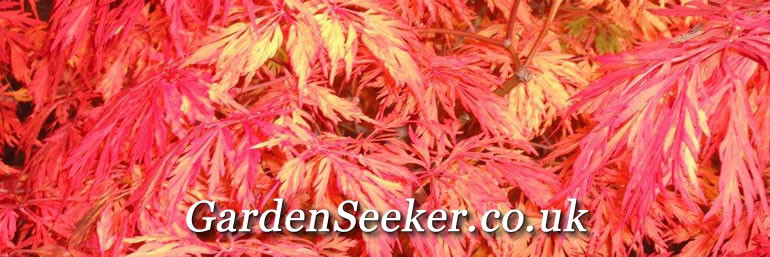
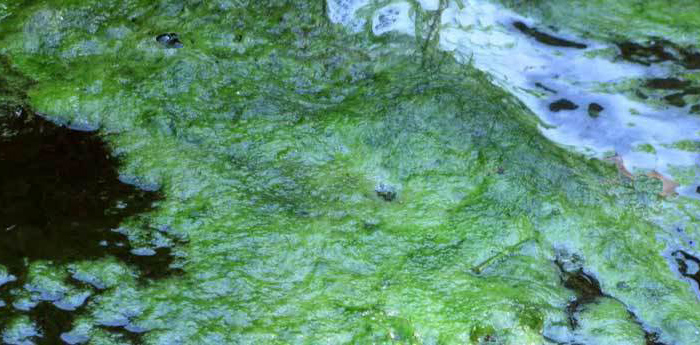
String Algae / Filamentous Algae in your Pond
The green stringy stuff in your pond is Filamentous Algae!
Filamentous Algae is commonly known as String Algae, Blanket Algae, Pond Moss or Blanket Weed. Whatever you commonly call it, it is Filamentous Algae.
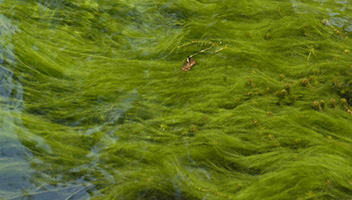
Flowing in a Stream
Filamentous algae are colonies of microscopic plants that link together to form threads, very fine, hair like, threads. They mass together to resemble flowing hair, if submerged, and like a dumped clumped blanket, if it is surfaced. These Microscopic plants have no roots and bind themselves onto almost anything in your pond. In flowing water it can look good. When it gets too heavy for its host, it breaks off and floats to the surface and clumps and mats together to form the blanket. This really does not look good.
Filamentous algae is important to the ecosystem, they produce oxygen and food for the animals that live in the pond, mainly snails, it is a hideaway from predators for small fry and very small pond life, but they also can cause problems such as clogs and stagnancy.
Filamentous algae will grow in healthy ponds, so dont panic, if you do not have bout of Filamentous algae throughout the summer, then there may be some imbalance in your pond. Filamentous algae feeds on nutrients within your pond, higher the nutrients, the quicker it can grow. It is a rapid grower and it can double in size within a day. If a fertiliser has leaked into your pond, Filamentous algae will grow quicker and thrive on the fertiliser.

Removing Filamentous Algae
Filamentous algae does not give off any toxins, therefore it is totally harmless to humans, pets or fish, my dog loves to drink pond water and does not get sick.
It produces oxygen and is a haven to small fry and other small aquatic insects. But, there is always a but, if left untreated and overgrown, some fish can get tangled up in its mass and can die.
In garden ponds, Filamentous algae can take over the whole pond. It will force and pen in your fish into pockets. The fish are then restricted to an ever decreasing pocket and then they can not find food and die.
Too much Filamentous algae is a problem to your fish.
Technically the answer is No. You should leave some Filamentous algae in your pond. Ideally cut back all your submerged Filamentous algae to 3 inches in length, but this could be a daily act with its rate of growth during the summer.
Personally, I get high growth in July and August and I try to eliminate it all, trust me, it grows back. I always remove the surface Filamentous algae, it looks ugly.
It is said that Koi Carp do eat the String Algae, but in my pond there is no evidence of this, I do keep my Koi Carp well fed, so that could be the answer why my string Algae grows. I would like to think, they do have a nibble, but the agressive nature of Blanket Weed means it grows quicker than the Koi Carp can eat. The common carp also eats the blanket weed, but neither are their first choice of food.
Snails do eat Filamentous algae and very are happy to do so. Especially the Ramshorn snails, they are brilliant at keeping your pond clean, healthy and full of life. Snails will keep your pond clear by eating away at algae on the sides of your pond.
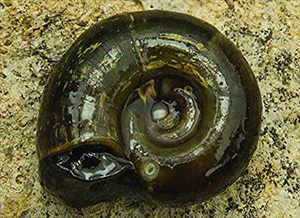
Ramshorn Pond Snail
Once Filamentous Algae starts to float, remove it with a small net and dispose it into your brown bin
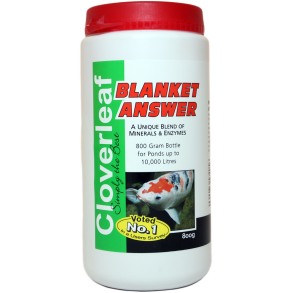
Cloverleaf Blanket Answer
Submerged Filamentous Algae is a little more difficult to do, even though it has no roots to pull up, it does cling and attach itself to the sides of your pond pretty good. I first use my net, scoop by scoop you finally get there. I read other people twist it round a wooden stake, equally as effective. These methods remove around 90% of the Filamentous Algae, you can remove the last remains by hand or I use a weak solution of chemicals to finish it off.
This is me, I use a weakened solution of 'Cloverleaf Blanket Answer', why weakened? Cloverleaf Blanket Answer turns your water a milky white colour, a full dose can discolour your water for up to 9 days. I use about a quarter strength and the next day the water is clear again. It works straight away, you will see the remaining Filamentous Algae is coated in the white blanket answer. Over the next few days it will change from milky white, to brown, to black and finally becomes sludge on your pond floor. This will need scooping out.
My Filamentous Algae does return and I have to re-apply the Blanket Answer probably three times a year. I am sure if I used a full strength mix, then this happen and you may have to re-apply annually. I like to see my happy fish, i do not like them living in the milky white water, who knows what they will get up to whilst I cant See them, lol.
This treatment is for small garden ponds only, see below for large ponds and lakes.
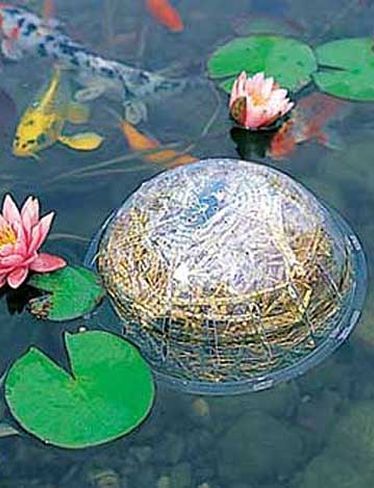
Floating Barley Straw Ball
The organic method I have not tried myself, but assured it works. Barley Straw, floating a small amount of Barley Straw in your pond will de-oxygenating your pond, this drains the properties which Filamentous Algae requires to thrive.
The application should be applied once annually and you should start the method in late spring, early summer. The Barley will let you know when it is complete, the Barley will turn black.
It is recommended that you use 2lb of Barley Straw per 1,000 Gallons of water, overdosing on the Barley Straw can have lethal implications on your fish and pond life.
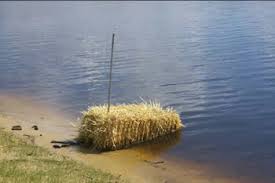
Barley Straw Bale
For small ponds, you can purchase purpose floatation devices filled with Barley Straw, simply float it in your pond until it turns black. Only black, remove it and dispose of it in your brown bin.
For large ponds and lakes, you can buy a bale of Barley Straw, just secure it on the edge of your pond. Once it turns Black, remove it and dispose accordingly.
Copper Sulphate is used to Control large amounts of Filamentous Algae in large ponds.
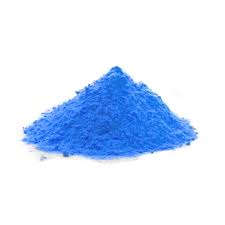
Copper Sulphate
Copper Sulphate is primarily used for agricultural purposes such as pesticide, germicide, a food additive, and a soil additive. In industry it is used as an electrolyte for batteries and electroplating baths, and in medical practice as a locally applied fungicide, bactericide, and astringent.
Copper Sulphate is sold in granular or powder format. Copper Sulphate is highly corrosive to Metal, be very careful when using it, always use plastic products and rubber gloves and protective clothes and goggles (be mindful if you have an industrial pump made of metal).
Copper Sulphate must be dissolved in warm water and mixed well, just throwing the granular pellets into the pond, wont work.
Use a sprayer and spray directly onto the floating Filamentous Algae, do not just add it to the water, Copper Sulphate needs direct contact to be effective. It will start to dissolve the Algae almost instantly.
Apply on half the pond first, wait 10 to 14 days and Apply on the second half. It is done this way to safeguard the wild life. If you have got the mixture wrong you have a chance of saving the wildlife and pond life.
Always read the lables for care and protection to yourself. It is safe for fish and other pond life as long as the application of Copper Sulphate and the dosage levels are correct.
You should treat floating Filamentous Algae with a solution of Copper Sulphate in late spring to early summer. Before the water gets too warm and do not apply when the water temperature just above freezing. IF the floating Filamentous Algae does return in the summer, you can apply a second dosage in similar conditions in the autumn. Not always necessary as Filamentous Algae dies off in the winter.
We are talking about large ponds / lakes here. The manufacture lables say 3 to 4 lbs of Copper Sulphate per Acre (4046.86 sqm).
Copper Sulphate is exceptionally effective in treating floating Filamentous Algae, but it is a toxic and corrosive substance. Copper sulphate is very toxic to fish, moderately toxic to birds, very toxic to invertebrates like snails, crustaceans, and insect larvae, as well as mammals if too much of the water is consumed or direct contact with the chemical is made. It’s highly water soluble, and should be used only in ponds and lakes that have liners that will prevent the chemical from leaking into the soil and thereby into other natural systems as well as drinking water.
Another warning, not only does the mix have to be correct level but if it is not mixed and diluted properly the copper sulphate will simply sink to the bottom of the pond. If it is eaten by a fish it will probably kill it.
Given these dangers, why use it, because it is the best cost effective method for large ponds and lakes
Filamentous Algae is good for the ecosystem, it produces oxygen and provides food and a safe haven for small fry and aquatic insects.
Some Filamentous Algae is good, but large amounts is bad for your fish and can be fatal.
Filamentous Algae has a large growth rate, it can double in size day to day, it is best to keep on top of it. In small garden pond: Regular removal by using a stick or net, use a Barley Straw Ball or use an application of Cloverleaf Blanket Answer.
For Large Ponds and lakes: use a bail of Barley Straw or an application of Copper Sulphate.
Our Major Issue is that when it becomes floating Filamentous Algae, it does not look good.